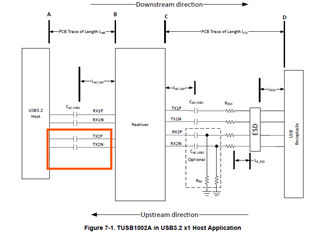Tool/software:
Hi,
I would like to confirm what AC cap should be used for TX to host.
As the USB3.2 standard and CPU (host) vendor recommend to use 330nF. But in TUSB1002A suggest to use 220nF.
Please clarify.
Thanks.

This thread has been locked.
If you have a related question, please click the "Ask a related question" button in the top right corner. The newly created question will be automatically linked to this question.
Tool/software:
Hi,
I would like to confirm what AC cap should be used for TX to host.
As the USB3.2 standard and CPU (host) vendor recommend to use 330nF. But in TUSB1002A suggest to use 220nF.
Please clarify.
Thanks.

Hello,
For this block diagram, the top lane (RX1P/N and TX1P/N pins of the TUSB1002A in this diagram) is the downstream direction of the USB host, which should be the TX lanes, hence recommending 220nF for TX.
The bottom lane (RX2P/N and TX2P/N pins of the TUSB1002A in this diagram) is the upstream direction from the USB receptacle, which should be the RX lanes of the USB3 signal, hence why 330nF is recommended in the section you have highlighted.
220nF is used on the TX lanes to meet the USB3.2 spec for AC coupling caps, while 330nF is used on the RX lanes to ensure compatibility between the host and device.
Please let me know if you have any other questions.
Thanks,
Ryan
Hi Ryan,
As in TUS1002 datasheet, it is mentioned that RX lane (TX2P/N and TX2P/N pins of the TUSB1002A in this diagram) to use 220nF. That's why I confuse here.
So, both side AC cap at RX2P/N & TX2P/N of TUSB1002A should use 330nF, am I correct ?
Hi Woon,
I see what you mean, I think I was a little confused.
After the signal moves through the redriver (Between TX2 P/N and the host,) the signal will lose its AC coupling, so it needs to be re-coupled. As such, the capacitors between TX2 P/N and the host need to be 220nF, that way the signals are AC coupled within the USB3 spec.
The AC caps before RX2 P/N are optional, and if they are placed, should be 330nF.
Please let me know if you have any other questions, and sorry for the confusion.
Thanks,
Ryan
hi Ryan,
Thanks for your detailed explanation.
As the host vendor (CPU vendor) mentioned the path of RX lane to host (Between TX2 P/N and the host) need to be 330nF following to USB3 spec, may I know with redriver application, this path need to be 330nF or 220nF ?
If the AC cap before RX2 P/N is 330nF, after redriver, it lose its AC coupling, then why the capacitors between TX2 P/N and the host need to be 220nF and not 330nF ?
Hi Woon,
If the AC cap before RX2 P/N is 330nF, after redriver, it lose its AC coupling, then why the capacitors between TX2 P/N and the host need to be 220nF and not 330nF ?
The RX2 P/N pins of the redriver connect to the TX lanes of the downstream device. These lanes should have their own coupling caps of values between 75nF to 265nF. As such, to ensure compatibility of the TX coupling caps on the device side with the optional RX coupling caps on the host side, we recommend 330nF to ensure that the AC coupling on the USB3 line does not dip below what is allowed in the USB3 spec.
However, the USB3 redriver will remove any coupling on the USB3 lines, regardless of what the coupling capacitor values are. As such, we need to ensure that the signal is coupled so that it does not violate the USb3 spec. Hence why that specific set of capacitors needs to be 220nF, to stay within that spec'd range of coupling.
Please let me know if you have any other questions.
Thanks,
Ryan